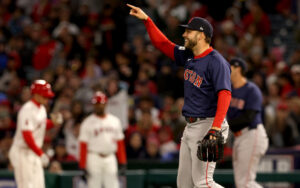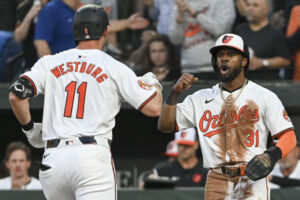Starting Pitching Reigns Supreme for the Indians
With the first series of the season under their belt, the biggest takeaway is that starting pitching is once again the strong fold of the Cleveland Indians. Zack Meisel who covers the Indians for The Athletic provided more context on the success of Cleveland’s starters, on Twitter.
Cleveland's starting pitchers, through three games:
19 innings, 13 H allowed, 2 BB, 30 K, 1.89 ERA
— Zack Meisel (@ZackMeisel) July 26, 2020
Shane Bieber kicked off the series Friday with a 14-strikeout game. Mike Clevinger followed Saturday by throwing 90 pitches – 60 of which were strikes. To conclude the series, Carlos Carrasco recorded five strikeouts Sunday with his slider which was his most effective pitch.
Going into this season, the Indians starting rotation depth was the strongest quality of the team. Even after trading Trevor Bauer to the Cincinnati Reds last July and losing Corey Kluber this past offseason in a trade with the Texas Rangers, Cleveland still has a talented group of starting pitchers on its big league roster.
Shane Bieber Kicks Things Off
Indians ace and American League Cy Young candidate Shane Bieber had his four-seamer and knuckle curveball working in Friday’s game. Bieber had 14 called strikes with his four-seamer while recording 13 swinging strikes with his knuckle curve. Bieber averaged 93.6 miles per hour (MPH) on his four-seamer. Meanwhile, his knuckle curve had an average velocity of 82.6 MPH.
Throughout the game, the Royals hitters had a hard time picking up on the depth of his four-seamer and Bieber effectively worked it around the strike zone. It was a big reason why the Indians were able to shut out the Royals.
According to Baseball Savant, Bieber accumulated a groundball rate of 28.6% through his first start. Furthermore, the right-hander amassed a first-pitch swing percentage of 65.2% and a 47.7% whiff rate. More specifically, with the knuckle curve, Bieber held Royals hitters to a .125 batting average and slugging percentage.
Mike Clevinger Provides the Sunshine
Following the brilliance of Shane Bieber, Mike Clevinger kept things going for the Indians Saturday. Right now, it’s fair to say that it’s hard to top the Indians 1-2 punch of Bieber and Clevinger. In fact, with the way the starting rotation performed this series, the Indians clearly have the best group of starters in the American League Central.
Last season, Clevinger started to turn the corner because he began relying on his slider a lot more. In 2018, the right-hander threw his slider 21.1% of the time. Last year, Clevinger relied on that pitch 25.5%.
During Saturday’s start, Clevinger induced seven swinging strikes against the Royals offense. Furthermore, he went the distance pitching seven innings, while allowing four hits and two earned runs along with six strikeouts on 90 pitches.
According to the Baseball Savant heat map, the most contact for Clevinger came in the middle of the strike zone. In addition, Royals hitters made some contact below the strike zone, right above the middle of home plate.
Carlos Carrasco Continues the Effectiveness
Although the Indians notched their first series win of the season on Sunday, the biggest storyline was that right-hander Carlos Carrasco made his 2020 season debut. Carrasco being healthy and back in action is a significant boost for Cleveland.
Carrasco had all five of his pitches working Sunday. He threw 29 sliders, 26 four-seamers, 20 changeups, eight curveballs, and four sinkers in the series finale. In total, Carrasco had an average velocity of 88.2 MPH on all of his pitches. Furthermore, Royals hitters averaged a 91.1 MPH exit velocity on those pitches.
Based on data from Baseball Savant, 35 of the 87 pitches that Carrasco threw were focused in the lower right-hand corner of home plate, outside of the strike zone. As has always been the case, he prefers working outside the strike zone itself. 56 of his pitches were based in those four quadrant areas.
The Rest of the Starting Rotation/Looking Ahead
As mentioned before, the Indians strength is their starting rotation. The team is fortunate to have at least six effective starting pitchers on their current big league roster. Next up is right-hander Aaron Civale who starts Monday against the Chicago White Sox. After that, the rotation turns to Zach Plesac who was named the fifth member of the rotation last week.
Adam Plutko is yet another pitcher capable of being in the rotation. When Cleveland named Plesac as it’s number five starter, that pushed Plutko to the bullpen. Additionally, the Indians have both Jefry Rodriguez and Logan Allen on their 40-man roster. Both Rodriguez and Allen are capable of starting for the Indians if needed.
Rodriguez pitched in 10 games for the team last year with eight of those appearances being as a starter. Over that span, he posted a 4.63 ERA with a 6.4 K/9 rate and a 1.479 WHIP.
After coming over to the Indians from the San Diego Padres, Allen was used exclusively as a reliever. However, with the Padres he made four starts in the eight games that he pitched with the big league club. The results were pretty sub-par though as Allen posted a 6.98 ERA over 19 1/3 innings as a starter. In that sample, he had an Opponent Batting Average Against (OBAA) of .329.
Further down on the depth chart as another option is right-hander Triston McKenzie. McKenzie is currently the team’s number nine overall prospect. While he could start towards the end of this season, next year is more likely for the 22-year old.
Main Image
Embed from Getty Images






